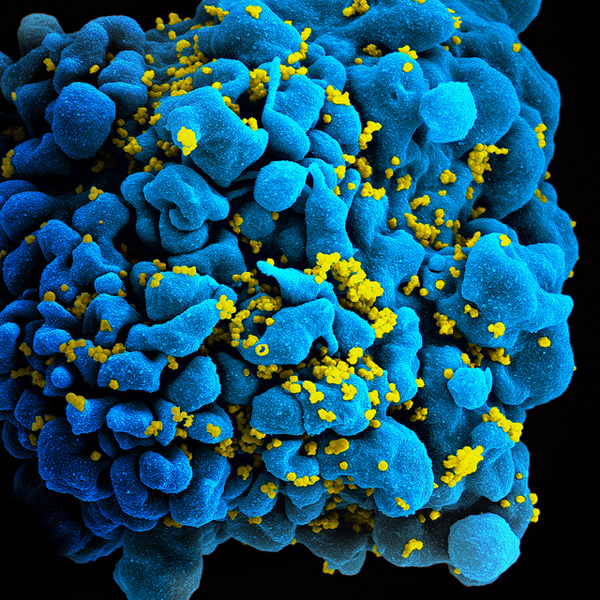Study seeks to identify high-risk youth and get them into medical care

Credit: National Institute of Allergy and Infectious Diseases, NIH
The National Institutes of Health has awarded $7.5 million for an international research program to prevent and treat HIV infection among adolescents and young adults in seven African countries and Brazil. The study, called Prevention and Treatment through a Comprehensive Care Continuum for HIV-affected Adolescents in Resource Constrained Settings (PATC3H), will support research to develop strategies to identify youth at risk of HIV infection and those living with HIV and to enroll them into medical care programs.
“It’s difficult to get high-risk adolescents into care, even under the best circumstances,” said Bill G. Kapogiannis, M.D., medical officer in the Maternal and Pediatric Infectious Disease Branch of NIH’s Eunice Kennedy Shriver National Institute of Child Health and Human Development (NICHD). “In poorer countries, the problem is compounded by lack of access to basic health care facilities and, too often, social stigma against people with HIV.”
According to the Joint United Nations Programme on HIV/AIDS , an estimated 1.6 million people ages 15 and older worldwide were newly infected with HIV in 2017.
Funding for the PATC3H study will be provided by NICHD and other NIH components, including the Office of AIDS Research, National Institute on Minority Health and Health Disparities, and Office of Behavioral and Social Sciences Research.
Dr. Kapogiannis explained that youth with HIV are less likely than adults to have their HIV infection diagnosed, to seek medical care, or to remain in the healthcare system if they have been diagnosed. Without medical care, young adults miss out on anti-HIV therapy, which keeps the virus in check and helps prevent its spread to others. Also, youth who are at high-risk for HIV infection often don’t access preventive treatments and interventions to reduce their chances of infection.
PATC3H researchers will devise and test strategies for reaching out to youth at-risk for HIV and for enrolling them into care. If the strategies are successful, they will receive additional funding to expand their care and treatment programs. The researchers have formed relationships with clinical sites and local agencies in the host countries involved in improving healthcare for at-risk youth. They also will collaborate with each other to refine and improve their individual programs.
The following are PATC3H study principal investigators and their programs:
Babafemi Taiwo, MBBS, Northwestern University Feinberg School of Medicine, Chicago.
Program: Enrolling young men who have sex with men in Ibadan, Nigerai, into a program to diagnose HIV and provide treatment for those who need it.
Pamela Kohler, Ph.D., University of Washington, Seattle.
Program: An effort to identify at-risk adolescent males and females at six HIV clinics in Western Kenya and to provide them with anti-HIV treatment, as appropriate. The researchers will also conduct a series of interviews with study participants to inform future research studies.
Juliet Iwelunmor, Ph.D., Saint Louis University.
Program: Increasing HIV testing among male and female at-risk youth in 24 areas in 4 states in Nigeria and enrolling those who test positive into care.
Sujha Subramanian, Ph.D., Research Triangle Institute, North Carolina.
Program: Offering adolescent girls and young women in Zambia regular testing for HIV and providing them with anti-HIV treatment and periodic health examinations.
Erin Meek, Ph.D., Public Health Foundation Enterprises, City of Industry, California.
Program: A social media campaign to reduce stigma toward young transwomen in four public health clinics in Rio De Janeiro, Brazil.
Diane Havlir, M.D., University of California, San Francisco.
Program: Community-based enrollments of at-risk adolescents and young adults into treatment and care in multiple clinics in rural Uganda and Kenya.
Elaine Abrams, M.D., Columbia University, New York.
Program: Enrolling at-risk male and female adolescents in Zambezia, Mozambique, into a diagnosis and care program.
Geri Donenberg, Ph.D., School of Public Health, University of Illinois at Chicago.
Program: Testing South African adolescent girls for HIV and other sexually transmitted infections and providing HIV treatment or preventive therapy, as appropriate.
###
About the Eunice Kennedy Shriver National Institute of Child Health and Human Development (NICHD): NICHD conducts and supports research in the United States and throughout the world on fetal, infant and child development; maternal, child and family health; reproductive biology and population issues; and medical rehabilitation. For more information, visit http://www.nichd.nih.gov.
About the National Institutes of Health (NIH): NIH, the nation's medical research agency, includes 27 Institutes and Centers and is a component of the U.S. Department of Health and Human Services. NIH is the primary federal agency conducting and supporting basic, clinical, and translational medical research, and is investigating the causes, treatments, and cures for both common and rare diseases. For more information about NIH and its programs, visit http://www.nih.gov

 BACK TO TOP
BACK TO TOP